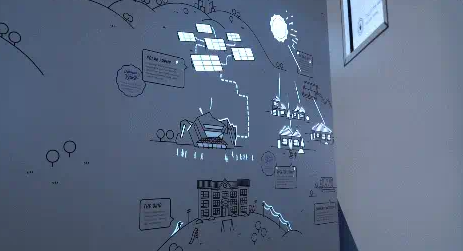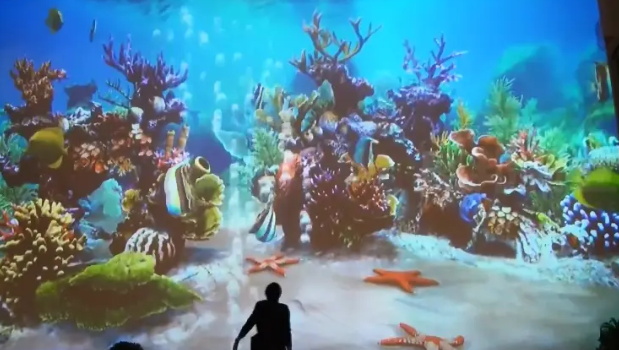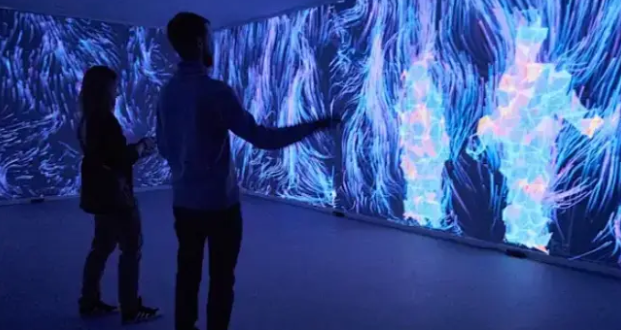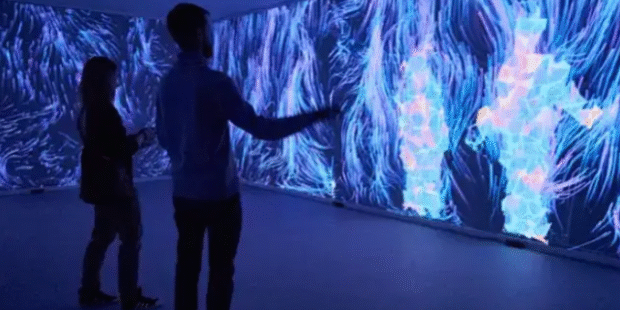Introduction: Bringing Walls to Life
In multimedia exhibition halls and digital museums, interactive wall projection technology has become one of the most engaging ways to connect with visitors. By projecting dynamic images onto walls and combining them with sensing technologies, static displays are transformed into immersive, game-like experiences. Visitors are no longer passive observers; instead, they interact directly with the exhibition, making the learning and entertainment experience more memorable.
Below, we explore three of the most common forms of interactive wall projection that are redefining exhibition design.
1. Conductive Ink Interactive Systems
Also known as Lidar Eye Interactive Walls, Electronic Ink Walls, or Hogwarts Walls, this technology has become a visitor favorite in multimedia exhibition spaces.

The conductive ink interactive wall system integrates education, science communication, and interactive games. By applying conductive materials to the wall, visitors can touch specific zones with their fingers to trigger dynamic visual or audio feedback.
- Immersive Interaction: Static illustrations come alive with light, color, and animation the moment they are touched.
- Functional Applications: Beyond playful animations, these systems can also be integrated with lighting control, media playback, and sound effects, making the wall both artistic and functional.
- Memorable Experiences: For example, when a visitor touches an image of a light bulb, the bulb glows and animates—bringing joy, surprise, and learning to the audience.
This system is widely appreciated for its strong interactivity and ability to merge creativity with technology.
2. Interactive Wall Projection Systems
The interactive wall projection system combines computer vision and projection technology to create a surreal, dynamic interactive world.

Visitors interact with projected images using body movement, gestures, or touch, allowing them to control and manipulate digital content in real-time.
- Virtual-Physical Integration: Visitors can zoom, rotate, or move projected elements such as maps, animations, or visual effects.
- Flexible Content Display: Any digital content—be it scientific diagrams, artworks, or corporate visuals—can be transformed into an engaging, interactive experience.
- Enhanced Storytelling: By merging reality and illusion, exhibitions create a sense of immersion and wonder that captivates audiences of all ages.
This form of projection is highly versatile, making it a powerful tool for exhibitions, trade shows, and brand storytelling.
3. Large-Screen Motion Sensing Technology
Large-screen motion sensing technology brings a futuristic gesture-based interaction model to multimedia exhibitions. Using 3D cameras, motion sensors, and custom software, it tracks visitors’ movements with high precision.

- Immersive Interaction: The content on the screen reacts instantly to gestures, allowing participants to “step inside” the display.
- Engaging Digital Content: From games to educational content, visitors experience a visual feast that connects their movements to real-time effects.
- Becoming Part of the Exhibition: Visitors shift from being mere spectators to becoming an integral part of the story—co-creating the display through interaction.
This cutting-edge approach is increasingly popular in science museums, cultural exhibitions, and corporate innovation centers.
CPJROBOT: Powering Next-Generation Interactive Experiences
As interactive technologies evolve, precise sensing becomes critical. This is where CPJROBOT excels.
- POE Interactive LiDAR: Delivers high-precision sensing for multi-touch walls, floor projections, and gesture-based interactions.
- Reception & Navigation Robots: Enhance visitor experiences in museums, airports, shopping centers, and hotels, offering seamless navigation and customer engagement.
- Customization & Innovation: CPJROBOT provides flexible, future-ready solutions for brands and institutions seeking cutting-edge interactive systems.
By integrating LiDAR sensing with interactive projection, CPJROBOT helps transform walls into intelligent, touch-sensitive surfaces that redefine digital engagement.
FAQs About Interactive Wall Projection
Q1: What is interactive wall projection?
A: It’s a technology that uses projection and sensing systems to allow visitors to interact with images, animations, or media on walls in real-time.
Q2: Which industries can benefit from interactive wall projection?
A: Museums, science centers, shopping malls, corporate showrooms, schools, and cultural exhibitions are the primary users.
Q3: Can multiple users interact at the same time?
A: Yes. Most systems support multi-touch or multi-user interactions, allowing groups to engage simultaneously.
Q4: How does POE LiDAR improve interactive projection?
A: LiDAR enhances accuracy and responsiveness, enabling precise multi-touch interaction and supporting more complex interactive designs.
Q5: Is the system customizable?
A: Absolutely. Interactive walls can be tailored in terms of content, appearance, sensing technology, and functionality to match the brand or exhibition’s theme.
Conclusion
Interactive wall projection is reshaping how visitors engage with multimedia exhibitions. From conductive ink systems to large-scale motion sensing walls, these technologies deliver immersive, memorable, and shareable experiences that connect with audiences on a deeper level.
Ready to transform your exhibition space into an unforgettable interactive experience?
Partner with CPJROBOT, a leader in POE interactive LiDAR and reception/navigation robots, to create customized solutions that bring your walls to life.







